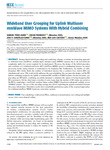| dc.contributor.author | Pérez-Adán, Darian | |
| dc.contributor.author | Fresnedo, Óscar | |
| dc.contributor.author | González-Coma, José P. | |
| dc.contributor.author | Castedo, Luis | |
| dc.date.accessioned | 2021-04-30T18:52:12Z | |
| dc.date.available | 2021-04-30T18:52:12Z | |
| dc.date.issued | 2021-03-10 | |
| dc.identifier.citation | D. Pérez-Adán, Ó. Fresnedo, J. P. González-Coma and L. Castedo, "Wideband User Grouping for Uplink Multiuser mmWave MIMO Systems With Hybrid Combining," in IEEE Access, vol. 9, pp. 41360-41372, 2021, doi: 10.1109/ACCESS.2021.3065581 | es_ES |
| dc.identifier.issn | 2169-3536 | |
| dc.identifier.uri | http://hdl.handle.net/2183/27873 | |
| dc.description.abstract | [Abstract]
Analog-digital hybrid precoding and combining schemes constitute an interesting approach to millimeter-wave (mmWave) multiple-input multiple-output (MIMO) systems due to the low hardware complexity and/or low power required for its deployment. However, the design of the hybrid precoders and combiners of a wideband multiuser (MU) mmWave MIMO system is challenging because the signal processing in the analog domain is constrained to be frequency flat. Furthermore, the number of radio frequency (RF) chains limits the number of individual streams that a common base station (BS) can simultaneously serve. This work jointly addresses the user scheduling, the user precoder design, and the BS hybrid combining design for the uplink of wideband MU mmWave MIMO systems. On the one hand, user precoding and BS hybrid combining are jointly designed to minimize the impact of having frequency-flat RF components. On the other hand, a number of users larger than the number of RF chains are served at the BS by employing a distributed quantizer linear coding (DQLC)-based non-orthogonal multiple access (NOMA) scheme. The use of this encoding strategy also allows exploiting the spatial correlation between the source information. Simulation results show remarkable performance gains of the proposed approaches for wideband mmWave MIMO hardware-constrained systems. | es_ES |
| dc.description.sponsorship | 10.13039/501100010801-Xunta de Galicia (Grant Number: ED431C 2020/15)
10.13039/501100010801-Centro de Investigación de Galicia CITIC (Grant Number: ED431G2019/01)
10.13039/501100011033-Agencia Estatal de Investigación of Spain (Grant Number: RED2018-102668-T and PID2019-104958RB-C42)
European Regional Development Funds (ERDF) of the EU (ERDF Galicia 2014-2020 & AEI/ERDF programs, UE)
Predoctoral (Grant Number: BES-2017-081955) | es_ES |
| dc.description.sponsorship | Xunta de Galicia; ED431C 2020/15 | es_ES |
| dc.description.sponsorship | Xunta de Galicia; ED431G2019/01 | es_ES |
| dc.language.iso | eng | es_ES |
| dc.publisher | Institute of Electrical and Electronics Engineers | es_ES |
| dc.relation | info:eu-repo/grantAgreement/AEI/Plan Estatal de Investigación Científica y Técnica y de Innovación 2017-2020/RED2018-102668-T/ES/ | |
| dc.relation | info:eu-repo/grantAgreement/AEI/Plan Estatal de Investigación Científica y Técnica y de Innovación 2017-2020/PID2019-104958RB-C42/ES/AVANCES EN CODIFICACION Y PROCESADO DE SEÑAL PARA LA SOCIEDAD DIGITAL | |
| dc.relation | info:eu-repo/grantAgreement/AEI/Plan Estatal de Investigación Científica y Técnica y de Innovación 2013-2016/BES-2017-081955/ES/ | |
| dc.relation.uri | https://doi.org/10.1109/ACCESS.2021.3065581 | es_ES |
| dc.rights | Atribución 4.0 Internacional (CC BY 4.0) | es_ES |
| dc.rights.uri | https://creativecommons.org/licenses/by/4.0/ | * |
| dc.subject | User scheduling | es_ES |
| dc.subject | Wideband mmWave | es_ES |
| dc.subject | Multiuser communications | es_ES |
| dc.subject | Non-orthogonal multiple access | es_ES |
| dc.subject | Joint source-channel coding | es_ES |
| dc.title | Wideband User Grouping for Uplink Multiuser mmWave MIMO Systems With Hybrid Combining | es_ES |
| dc.type | info:eu-repo/semantics/article | es_ES |
| dc.rights.access | info:eu-repo/semantics/openAccess | es_ES |
| UDC.journalTitle | IEEE Access | es_ES |
| UDC.volume | 9 | es_ES |
| UDC.startPage | 41360 | es_ES |
| UDC.endPage | 41372 | es_ES |
| dc.identifier.doi | 10.1109/ACCESS.2021.3065581 | |






